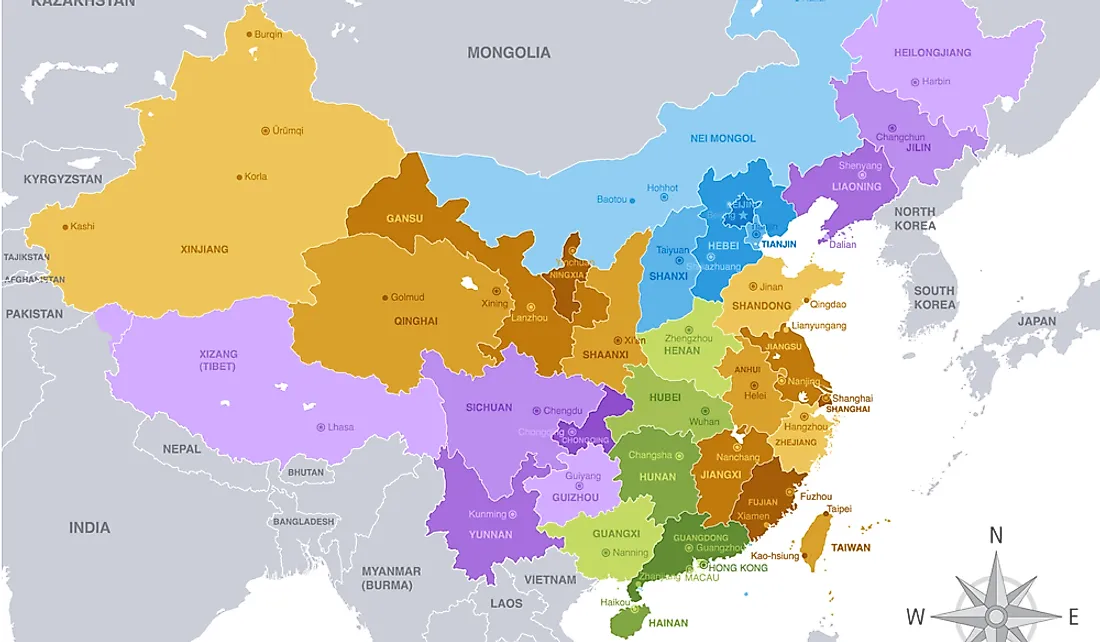Chinese Administrative Divisions by Size

China is the world’s most populated county having an approximate population of 1.404 billion people. China is also the fourth largest country by land area covering a total area of about 9,600,000 square kilometers. Due to its massive land size and high population, China has since been divided into a number of administrative divisions for ease of administration. China has thus been divided into 22 provinces, five autonomous regions, four municipalities, and two special administrative regions. The provinces form the first and the highest level of Chinese administrative division. Just like the provinces, the autonomous regions also have their local governments. The only difference is that autonomous regions gave more legislative rights than the provinces. The regions of Xinjiang, Tibet, and Inner Mongolia are the largest covering over 1,000,000 square kilometers each.
Largest Chinese Administrative Divisions By Size
Xinjiang - 1,664,900 square km
This region is the largest of all the administrative regions in China, and it covers an area of 1,664,900 Kilometers square. Xinjiang, in the northwest part of China, has rich geography that is dotted with mountains, lakes, rivers, and desert. The administration is autonomous although it still adheres to the Communist Party doctrine. The place is also home to the Muslim minority group called the Uighurs and other groups in the region. The region has also been in the focus of international press coverage with reports of human rights abuses against the minorities by the Beijing government, which maintains a significant presence in the region’s administrative centers.
Tibet - 1,228,400 square km
The region is famous for being the birthplace of the spiritual leader, Dalai Lama. Founded in 1962 after the Chinese takeover, The Tiber Autonomous Region was divided into seven administrative subdivisions with Lhasa being the headquarters. From its location in the southwest, the region is ruled from Beijing despite the relative autonomy over matters like education or language policy. The administration is similar to other provincial governments with the Communist Party still having considerable influence in governance. The terrain of the place is seemingly harsh, and it could explain why the region has fewer people living here in spite of its size. Tourism is among the main contributors to its economy ever since the government in Beijing allowed international tourists to visit Tibet.
Inner Mongolia - 1,183,000 square km
The third largest administrative region located in the north of the country. It has autonomy to create and implement economic policies as per the guidelines of the Communist Party. The region covers an area of 1,183,000 square kilometers and is populated by the Han Chinese, who are the majority of people, and the ethnic Mongols who are the minorities. Established in 1947, the region is known for its abundance of resources like natural gas and coal, which are exploited for their potential to bring huge returns. Facilities of the Chinese Space Agency are found here especially the launch facilities since its founding in 1953.
Qinghai - 722,300 square km
The north-western region is regarded as a province, and it has a similar administrative structure to that of provincial governments. However, it is decentralized based on the ethnic composition of the region which is comprised of the majority Han Chinese ethnic group. The region is structured to ensure that there is no dominance of any ethnic group over the other; hence, it is not autonomous like other regions. Qinghai covers an area of 722,300 kilometers square, ranking it among the largest regions in China. The city of Qinghai is a major tourist destination; its warm weather and the museums showcase the rich history of the region.
Other Administrative Divisions
The Chinese model is careful enough not to upset local interests and at the same time retain the authority of the Beijing government and the Communist Party policies. The administrative divisions discussed above are the top regions regarding their land areas, but there are more divisions including Sichuan, Heilongjiang, Gansu, Yunnan, Guangxi, Hunan, among others.
Special Administrative Divisions
The People’s Republic of China is made up of 31 administrative divisions and two special administrative divisions. The two special administrative divisions are Hong Kong and Macau. Hong Kong is located in Southern China; this province covers a total area of 1,104 square kilometers. Hong Kong has an approximate population of 7.4 million people. Macau is also an autonomous territory of China covering an area of 30.5 square kilometers. Unlike Hong Kong, Macau has a relatively small population, i.e. approximately 650,900 people.
Chinese Administrative Divisions by Size
| Rank | Name | Area (square km) |
|---|---|---|
| 1 | Xinjiang | 1,664,900 |
| 2 | Tibet | 1,228,400 |
| 3 | Inner Mongolia | 1,183,000 |
| 4 | Qinghai | 722,300 |
| 5 | Sichuan | 486,100 |
| 6 | Heilongjiang | 454,800 |
| 7 | Gansu | 425,800 |
| 8 | Yunnan | 394,100 |
| 9 | Guangxi | 237,600 |
| 10 | Hunan | 211,800 |
| 11 | Shaanxi | 205,800 |
| 12 | Hebei | 188,800 |
| 13 | Jilin | 187,400 |
| 14 | Hubei | 185,900 |
| 15 | Guangdong | 179,700 |
| 16 | Guizhou | 176,200 |
| 17 | Henan | 167,000 |
| 18 | Jiangxi | 166,900 |
| 19 | Shandong | 157,100 |
| 20 | Shanxi | 156,700 |
| 21 | Liaoning | 148,400 |
| 22 | Anhui | 139,400 |
| 23 | Fujian | 123,900 |
| 24 | Jiangsu | 102,600 |
| 25 | Zhejiang | 101,800 |
| 26 | Chongqing | 82,400 |
| 27 | Ningxia | 66,140 |
| 28 | Hainan | 35,354 |
| 29 | Biejing | 16,411 |
| 30 | Tianjin | 11,917 |
| 31 | Shanghai | 6,340 |
| 32 | Hong Kong | 1,105 |
| 33 | Macau | 31 |











